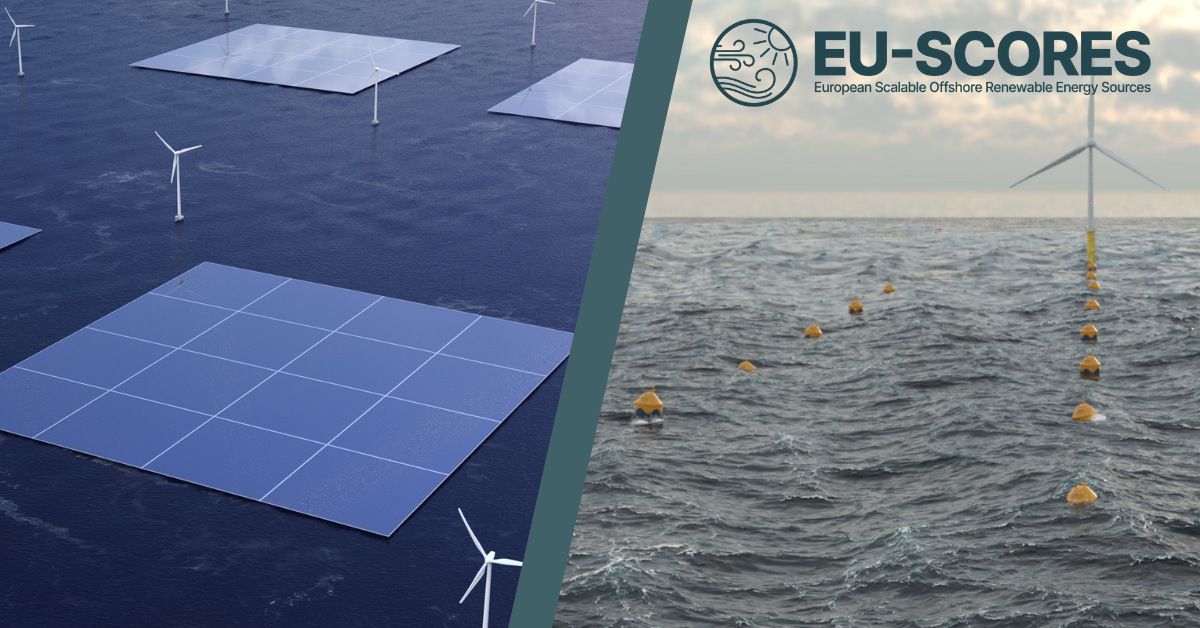Co-location of offshore wind, wave and offshore solar energy could lead to unprecedented LCOE reduction (original) (raw)

Image Credit: Oceans of Energy, CorPower Ocean
Co-location of offshore wind, wave and offshore solar energy in multi-source energy parks could lead to unprecedented LCOE reduction and improves the efficient use of marine space. This conclusion is presented in the report ‘LCOE Analysis for Baseline Project Scenarios’ by EU-SCORES project partner Exceedence in collaboration with CorPower Ocean, Oceans of Energy, Dutch Marine Energy Centre (DMEC), EDP Labelec (EDP), WavEC and LUT University.
LCOE reduction for wave and offshore solar energy
In the report, baseline financial models are presented for a range of individual and combined offshore renewable energy projects investigated in the EU-SCORES project. Based on data provided by the consortium partners CorPower Ocean (wave energy) and Oceans of Energy (floating solar) LCOE reduction of wave and offshore solar energy is driven by:
- Supply chain economies of scale;
- Advanced installation and O&M experience and services;
- Learning rates and an increase of skilled labour and expertise;
- Improved mooring and floating substructure design.
Looking at the EU-SCORES LCOE target of 50 EUR per MWh it can be seen that both wave and floating solar energy are capable of reaching this target independently. However co-location proposed by EU-SCORES will see this target achieved sooner and with less cumulative deployment.
EU-SCORES project: multi-source energy parks
By combining offshore wind, wave and offshore solar energy in multi-source energy parks as proposed by the EU-SCORES project, the LCOE of wave and offshore solar energy is expected to be further reduced. The co-location of offshore wind, wave and floating solar energy and its benefits will be further demonstrated throughout the project.
Co-location benefits include shared use of critical electrical infrastructures, i.e. substations and cables, but also marine vessels, combined operation and maintenance methodologies, complementary generation profiles and grid balancing, project co-development and maximum-utalisation of marine space needed.
The EU-SCORES project aims to pave the way for bankable hybrid offshore energy parks across Europe by 2025. Under the project lead of the Dutch Marine Energy Centre (DMEC), EU-SCORES will support the industry to unlock the large-scale potential of wind, wave and offshore solar systems.
LCOE
Oceans of Energy indicates an LCOE of between 120 and 150 EUR per MWh by 4MW cumulative installed capacity (expected during EU-SCORES in 2023), to drop below 100 EUR per MWh by 2025, and to drop below 50 EUR per MWh by 2030.
CorPower Ocean projects its LCOE to drop to 70 EUR per MWh at 600MW installed, and 30-40 EUR per MWh after 20GW installed.
EU-SCORES Consortium Partners
The EU-SCORES consortium partners are: Dutch Marine Energy Centre (DMEC), Oceans of Energy, TU Delft, SBM Offshore, POM West-Vlaanderen (POM), RWE Renewables (RWE), CorPower Ocean, Uppsala University, Lappeenranta-Lahti University of Technology (LUT), Enel Green Power, RINA offshore consultants, INNOSEA – a AqualisBraemar LOC Group company, EDP Labelec, WavEC Offshore Renewables, INESC TEC, Exceedence, Western Star Wave – a Simply Blue Group company.
Supporting partners_:_ ENECO Group, Energie Baden-Württemberg, ENI, IRO (Association of Dutch Suppliers in the Offshore Energy Industry), Meewind, Ocean Energy Europe, Ocean Winds, Parkwind, Redes Enérgeticas Nacionais and TenneT.
More information
To download the full report please click here.
For more information please contact Benjamin Lehner.